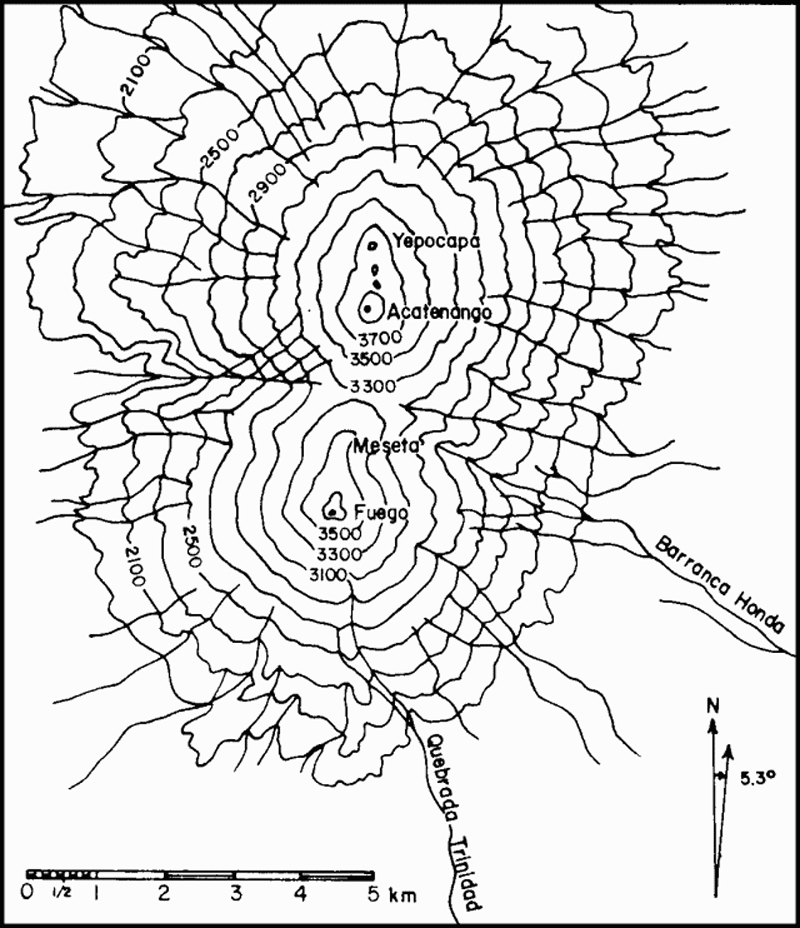Report on Fuego (Guatemala) — November 1978
Scientific Event Alert Network Bulletin, vol. 3, no. 11 (November 1978)
Managing Editor: David Squires.
Fuego (Guatemala) Avalanches from new block lava flow; brief moderate Vulcanian activity
Please cite this report as:
Global Volcanism Program, 1978. Report on Fuego (Guatemala) (Squires, D., ed.). Scientific Event Alert Network Bulletin, 3:11. Smithsonian Institution. https://doi.org/10.5479/si.GVP.SEAN197811-342090
Fuego
Guatemala
14.4748°N, 90.8806°W; summit elev. 3799 m
All times are local (unless otherwise noted)
After a month of dome growth and weak steaming, lava flow extrusion began in late October and was continuing in late November.
The following is from Paul Newton. Fuego's activity was limited to weak steaming from 24 October until the evening of 28 October, when a loud explosion was heard at 1930. About 30 minutes later, avalanches of glowing ash and some large blocks began to travel down Barranca Honda (figure 1), a canyon on Fuego's E flank. Hot avalanches continued through at least 1130 the next day, accompanied by weak steaming. The SE side of the summit dome appeared "distorted" from Antigua. Clouds then obscured the volcano until 1830 when a glow was visible over the summit but hot avalanches had ceased.
Only minor steaming was observed between 30 October and 4 November. The vapor column reached 700 m in height on 5 November. Incandescent avalanches resumed by the evening of 6 November, stopped by the next morning, then began again during the evening of the 7th and continued through 12 November, the last day of Newton's observations. Weak steaming and occasional emission of dark gray ejecta to a maximum observed height of 500 m accompanied the avalanches. Earthquakes were felt in Antigua at 1224 and 1312 on 30 October, and at 0030 on 31 October.
The following report, by Dennis Martin, is based on observations from the E side of Fuego 19-20 November, and from Alotenango (at Fuego's NE foot) beginning 21 November, plus conversations with local residents. "An incandescent lava flow about 300 m long extruded from a vent just E of and below the summit was flowing down Barranca Honda. Where the slope within the barranca steepens to more than 60°, the flow formed a spectacular lava cascade where incandescent lava blocks dropped hundreds of meters. Extending about 3 km further down the Barranca to elevations of about 2 km was a block avalanche fed by accumulations of incandescent blocks from above. This avalanche continually oversteepened and produced its own incandescent cascades. At night, incandescence from the block avalanche disappeared below about 3 km elevation. Because of accumulations high in Barranca Honda, a block avalanche had began to advance down an adjacent canyon (N of Barranca Honda) in mid-November. Both avalanches had reached a point about 6 km from National Route 14, where the nearest people live. Weak, sporadic lava fountaining at the summit mound and gas emission from an apparent 500-m-long N-S fissure accompanied the lava flow.
"A moderate Vulcanian eruption, similar in intensity to the 29-31 January events began at 0030 on 21 November. The eruption cloud rose more than 2 km and was blown WSW and W. Incandescent blocks were thrown to a height of a few hundred meters. An apparent ash flow descended the Barranca Honda at 0430. The loudest of nearly continuous audible explosions heard at Antigua occurred at 0600, but by 0900 the eruption was clearly decreasing in intensity and continued to do so for the rest of the day. By the evening of 22 November, the Vulcanian activity had declined to 1-2-minute explosions at about 2-hour intervals. The lava flow activity of the previous weeks continued during the Vulcanian eruption."
Geological Summary. Volcán Fuego, one of Central America's most active volcanoes, is also one of three large stratovolcanoes overlooking Guatemala's former capital, Antigua. The scarp of an older edifice, Meseta, lies between Fuego and Acatenango to the north. Construction of Meseta dates back to about 230,000 years and continued until the late Pleistocene or early Holocene. Collapse of Meseta may have produced the massive Escuintla debris-avalanche deposit, which extends about 50 km onto the Pacific coastal plain. Growth of the modern Fuego volcano followed, continuing the southward migration of volcanism that began at the mostly andesitic Acatenango. Eruptions at Fuego have become more mafic with time, and most historical activity has produced basaltic rocks. Frequent vigorous eruptions have been recorded since the onset of the Spanish era in 1524, and have produced major ashfalls, along with occasional pyroclastic flows and lava flows.
Information Contacts: D. Martin and W. Rose, Jr., Michigan Tech. Univ.; P. Newton, Antigua.


